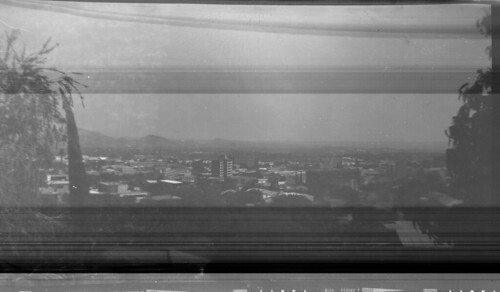I’ve mentioned it before, and I still can’t tell you why: I like taking old rolls of film I come across, and getting them developed to see what secrets they hold. It costs much more than modern film, and probably half the time there are no pictures to be salvaged. People think it’s weird – but when I successfully get an image, it’s fun to wonder who the people are in the photo (it seems like old photos always have people as their subject) – and why the photographer thought a particular image was worth capturing on film. And then completely forgetting about it. Maybe they got a new camera and the old one was set aside for 60 years – who knows?
Before you get your hopes up, this is one of those times I didn’t get an image.
Awhile back I picked up an old Six-16 Brownie Special which was said to contain a partly exposed roll of film. The thing about a Six-16 is that it uses 616 film (strange coincidence, I know!). But 616 film is a variation of 116 film – it just has a thinner spool. Neither 616 nor 116 film have been made in years, and are extremely hard to get your hands on. Other film types can be cut from 120 film, but 616/116 are wider than standard 120 film, removing this option. This is what it looks like, in comparison to the slightly shorter 120 roll:
So I had high hopes when I received the camera, with its roll of film that had been wound to exposure number 3. I was hopeful that numbers 1 and maybe even 2 would turn out. I quickly snapped a few photos to use up the roll and sent it off.
While we wait for the film to be developed and return, a bit more background: the camera itself was manufactured between 1938 and 1942. It took negatives that were 2.5 inches by 4.25 inches – compare that to 12o film which takes 6 x 9 cm exposures (2.4 by 3.6 inches) and 35mm film, which takes 24 x 36 mm exposures (less than one inch by 1.4 inches). The Brownie Six-16 had a trapezoidal shape to accommodate the wider-than-normal exposure, as seen in the photos below:


You could turn the camera either way – to take landscape-like photos, or very tall photos. The switch under the lens would change the focus to over/under 15 feet, and there was also a switch to leave the shutter open for an extended period. I have a couple of these, and I’ve noticed that the mechanism to prevent the shutter release from accidentally being pushed, 80 years after the camera was manufactured, sometimes makes it difficult to release the shutter on purpose. It’s a heavy camera, made of metal, and on many of them (like this one) the leather strap on top is damaged or missing.
So back to the photos. It turns out that the years were not kind to the photos that had been taken by the previous owner. It could also be that no photos were taken, and someone advanced the film with the camera open, curious to see how it worked. But I wish I had paid more attention when I snapped the additional photos, because those actually turned out. Though the film was manufactured all the way through the 1980s, the Kodacolor-X film used in this camera was manufactured between 1963 and 1974. That means that this film was at least 40 years old. The C-22 process was discontinued years ago, and the film was processed as black and white film. I think it’s remarkable for an 80-year-old camera using 40-year-0ld film:


So what’s next? Well, since Blue Moon Camera was kind enough to send back the spool with the backing paper intact, I may try rigging the spool up with some 120 film, and seeing what I can accomplish with the camera and some newer film.


